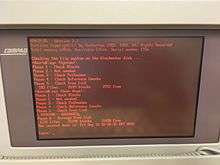Venix

| Developer | VenturCom |
|---|---|
| OS family | Version 7 Unix/System V |
| Working state | Historic |
| Initial release | 1983 |
| Latest release | 4.2.1 / 1994 |
| Available in | English |
| Platforms |
DEC PRO-350 (PDP-11 compatible), DEC Rainbow 100, IBM PC |
| Default user interface | Commandline (early version), X Window System, Motif, OpenLook |
Venix is a discontinued version of the Unix operating system for low-end computers, developed by VenturCom, a "company that specialises in the skinniest implementations of Unix".[1]
A working version of Venix for the IBM PC XT was demoed at Comdex in May 1983. It was based on Version 7 Unix with some enhancements from BSD (notably vi and csh) and custom inter-process communication mechanisms.[2] In September 1984, Venix/86 Encore was released; it supported a number of early PC-compatibles, including the AT&T 6300, the Zenith 150, the (first) NCR PC, and the Texas Instruments Professional PC.[3]
Venix Encore, which became Venix 2.0, was still based on Version 7 Unix, and ran on the DEC Rainbow 100 (Venix/86R) as well as PCs (Venix/86 and /286).[4] The system contained a number of enhancements, notably tools to access MSDOS files directly on a DOS/FAT-partition and an updated ADB debugger. The system came in two flavors, a 2-user version priced at $800 and a 8-user version at $1,000. There were no technical differences between the two.[5] Confusingly, Venix 2.0 for the DEC PRO-380 microcomputer (Venix/PRO) was based "essentially" System III. It no longer ran on the Pro350.[6] This is made clear in the ckermit 4E build instructions which has a special target for Pro running Venix 1.0, but instructs the user to use the sysiii target for Pro running Venix 2.0. These same sources also make it clear that Venix had an enhanced TTY interface relative to a pure V7 Unix System.[7] Venix 2.1 was released for at least the PCs.[8]
From version 3.0, Venix was based on System V. A real-time version based in System V.3.2 was released for the 386 in 1990.[1]
The last version Venix 4.2.1 based on UNIX System V Release 4.2 (UnixWare) was released in 1994. The workstation system included the real-time operating system, NFS and TCP/IP networking, X, OpenLook and Motif GUIs and the Veritas journaling File System (vxfs). A development system included additionally an ANSI C compiler, a library of real-time functions, GUI development software, real-time development utilities, and selected industrial I/O device drivers.
Reception
PC Magazine in 1984, found Venix functional, despite some bugs in the initial versions. Its use of the BIOS for accessing devices made it more portable than its competitor PC/IX, but slowed down its display processing; the disk access speed was found to be similar.[2] BYTE stated that Venix on the DEC Professional and IBM PC "performed adequately", but criticized its limit on background processeses.[9]
See also
References
- 1 2 VenturCom ships real-time Venix/386. Computer Business Review, 1 February 1990. Retrieved 23 March 2013.
- 1 2 Mark S. Zachmann (12 June 1984). "A Venerable UNIX". PC Magazine: 246–248. ISSN 0888-8507.
- ↑ "Enhanced Venix/86 out". Computerworld: 76. 17 September 1984. ISSN 0010-4841.
- ↑ "Enhanced VENIX/Rainbow". 16 December 1986.
- ↑ Roberts, S.D. (1985). Unix, Xenix & Venix. Germany: ELCOMP Publishing Inc. p. 193. ISBN 3-88963-064-2.
- ↑ "README".
- ↑ "Kermit Archive".
- ↑ "VenturComm Venix/86 on MESS/MAME".
- ↑ Hinnant, David F. (Aug 1984). "Benchmarking UNIX Systems". BYTE. pp. 132–135, 400–409. Retrieved 23 February 2016.
Further reading
- William B. Twitty (1984). UNIX on the IBM PC. Prentice-Hall. ISBN 978-0-13-939075-3. Covers and compares PC/IX, Xenix and Venix.
- Christine McGeever (14 January 1985). First Unix for the PC AT. InfoWorld. p. 23. ISSN 0199-6649.
External links
- Professional 325, 350, 380
- DEC PRO-350 emulator with VENIX disk images
- Installing Venix 2.1 in MAME/MESS